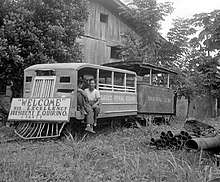Davao Prison and Penal Farm
Davao Prison and Penal Farm, formerly the Davao Penal Colony (DaPeCol), was established on January 21, 1932 in Panabo City, Davao del Norte, Philippines. It has a land area of 30,000 hectares with a prison reservation of 8,000 hectares. During World War II, the Davao Penal Colony was the biggest prison establishment in the country which was used by the Japanese invading army as their imperial garrison.[1]
 ″Welcome″ His Excellency President E. Quirino & Party | |
.svg.png) Davao Prison and Penal Farm | |
| Location | Panabo, Davao del Norte |
|---|---|
| Coordinates | 7°24′58″N 125°37′11″E |
| Status | Operational |
| Opened | January 21, 1932[1] |
| Former name | Davao Penal Colony |
| City | Panabo |
| State/province | Davao del Norte |
| Postal code | 8105 |
| Country | Philippines |
Brief History
On October 7, 1931, Governor Dwight Davis signed proclamation 414 which reserved a site for Penal Colony in Davao Province in Mindanao and on January 21, 1932 by virtue of Act No. 3732, the Davao Penal Colony was formally established. During World War II, it was used by the Philippine-American Armed Forces where more than 1000 Japanese were treated in accordance with the orders of the American commanding officer. The Japanese Imperial Army attacked Davao on December 20, 1941 and the colony was among the establishments that were taken over by the Imperial Army.[1]
| Davao Penal Colony | |
|---|---|
| Concentration camp | |
| Location | Panabo, Davao del Norte, Japanese-occupied Philippines |
| Number of inmates | 2,000 (est.) |
The Japanese kept two thousand American prisoners in the penal colony. When twelve men escaped, later joining Wendell Fertig's guerrillas, the Japanese beheaded twenty-five prisoners. Major Stephen Mellnik, of Douglas MacArthur's South West Pacific Area (command), inserted the M1 S-X intelligence officer Capt. Harold Rosenquist into Mindanao in an attempt to rescue the Americans before they could be moved. However, the Japanese had already evacuated the camp, placing the American prisoners on a ship bound for Japan. However, that ship was sunk by an American submarine, and only eighty-three reached shore and were rescued by guerrillas.[2]:395–397[3]:21–23
See also
- William Dyess
- Jack Hawkins
- Samuel Grashio
- Austin Shofner
References
- "Davao Prison and Penal Farm". Bureau of Corrections. Retrieved 14 October 2018.
- Keats, J., 1963, They Fought Alone, Philadelphia: J.B. Lippincott Company
- Childress, C., 2003, Wendell Fertig's Fictional "Autobiography":A Critical Review of They Fought Alone, Bulletin of the American Historical Collection, Vol. 31, No. 1 (123), Jan. 2003